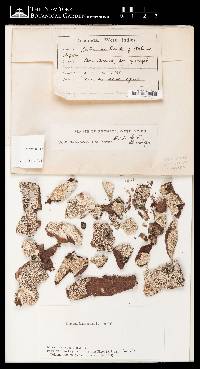
- Home
- Search
- Images
- Species Checklists
- US States: O-Z >
- US National Parks
- Central America
- South America
- US National Parks
- Southern Subpolar Region
|
|
|
|
Family: Ochrolechiaceae
[Pertusaria commutata Müll.Arg., morePertusaria copiosa Erichsen, Variolaria commutata (Müll. Arg.) Lendemer, R.C. Harris & A.M. Ruiz nom. inval.] |
MB# 821147 TYPE. VENEZUELA. Caracas, Ernst s.n. (G, lectotype designated by Archer 1997; US, isolectotype). Description. Life form: lichenized fungus. Thallus crustose, dull pale gray, continuous; surface wrinkled, rimose. Vegetative diaspores absent. Photobiont chlorococcoid alga. Ascomata disciform apothecia, numerous and crowded, sessile, 0.4-0.8 mm diam., disk coarsely white pruinose, appearing as soralia. Asci clavate, sometimes curved, 125-150 x 35-60 μm, 1-spored; ascospores uncommon, simple, hyaline, ellipsoid, 100-135 x 35-50 μm, walls smooth, ~1 μm thick. Chemistry. UV+ bright yellow, K+ yellow, KC-, C-, medulla and pruina PD+ yellow or orange; lichexanthone and haemathamnolic acid detected by TLC. Substrate and Habitat. Corticolous. Distribution. Australia, North and South America; in North Carolina found throughout. Literature Archer, A.W. (1991) New species and new reports of Pertusaria (lichenised Ascomycotina) from Australia and New Zealand with a key to the species in Australia. Mycotaxon 41(1): 223-269. Lendemer, J.C. & R.C. Harris (2017) Nomenclatural changes for North American members of the Variolaria-group necessitated by the recognition of Lepra (Pertusariales). The Bryologist 120(2): 182-189. Müller, J. (1884) Lichenologische Beiträge XIX. Flora (Regensburg) 67(14): 268-274 (original description as Pertusaria commutata). |












































































































